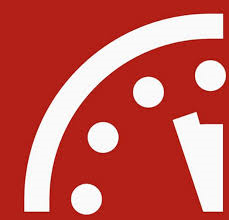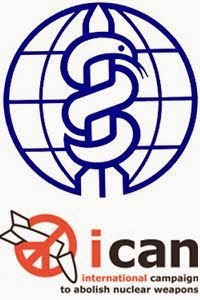Friends,
Ai Satoh of the Japan Council against A & H Bombs (Gensuikyo) shared the following speech given by Ms. Setsuko Thurlow, a Hibakusha of Hiroshima, to the First Committee of the United Nations General Assembly just the other day. Like so many other Hibakusha, Setsuko has dedicated herself to sharing the tragedy of Hiroshima and Nagasaki and preventing future nuclear war.
It is right that Setsuko spoke at the United Nations, an organization brought forth "to save succeeding generations from the scourge of war." Of course, nuclear war would be a scourge unlike anything humankind has ever known, and the nations that have "united" to "live together in peace" must work with a will to abolish nuclear weapons.
 |
| Setsuko Thurlow, Hibakusha of Hiroshima |
It is unconsionable that one nation would withold its financial debt to this family of nations to which it belongs, no matter how imperfect the U.N. might be. Rather than trying to tear it down the United States should be working to build it up, and updholding all its obligations both those of a financial nature as well as legal ones.
The duty, under international humanitarian law, to bring an end to the threat of nuclear weapons is clear. Of all the voices that speak, only those of the Hibakusha speak from the direct experience of nuclear horror, a horror that if ever unleashed again will make the horrific experiences of Hiroshima and Nagasaki pale in comparison.
For the 18th consecutive year, the General Assembly's First Committee
passed a resolution on October 26th calling for the eradication of nuclear arms. Japan submitted the resolution, which had broad support. A plenary session of the General Assembly is expected to vote on the resolution this December.
May we hear the message of the Hibakusha, and may we support the efforts of the United Nations to abolish nuclear weapons once and for all. May we stimulate younger generations to (in Setsuko's words) "continue the struggle to outlaw and eliminate the last remaining weapon of mass destruction: nuclear weapons."
Peace,
Leonard
****************
United Nations General Assembly First Committee
October 26, 2011
Ms. Setsuko Thurlow
Dear Members of the First Committee and guests,
I am privileged to have this opportunity to share with you a small part of my experience of the atomic bombing of Hiroshima.
On August 6, 1945, as a 13 year-old grade 8 student in the Student Mobilization Program I was with about 30 other girls working at the Army headquarters as a decoding assistant. The building was 1.8 km from the hypo-centre. At 8:15 a.m., the moment I saw a brilliant bluish-white flash outside the window, I remember having the sensation of floating in the air. As I regained consciousness in the silence and the darkness, I found myself pinned by the ruins of the collapsed building. I could not move, and I knew I was faced with death. I began to hear my classmates’ faint cries, “Mother, help me” “God, help me”. Then, suddenly, I felt hands touching my left shoulder, and heard a man’s voice saying, “Don’t give up! Keep moving! I am trying to free you. See the light coming through that opening. Crawl towards it and get out as quickly as possible.” As I came out, the ruins were already on fire. Most of my classmates who were with me in the same room were burned alive. A soldier ordered me and two other surviving girls to escape to the nearby hills.
I looked around. Although it was morning, it was dark as twilight, with dust and smoke rising in the air. I saw streams of ghostly figures, slowly shuffling from the centre of the city towards the nearby hills. They were naked and tattered, bleeding, burned, blackened and swollen. Parts of their bodies were missing, flesh and skin hanging from their bones, some with their eyeballs hanging in their hands, and some with their stomachs burst open, with intestines hanging out. We girls joined the ghostly procession, carefully stepping over the dead and dying. There was a deathly silence broken only by the moans of the injured and their pleas for water. The foul stench of burned skin filled the air.
At the foot of the hill was an army training ground, about the size of two football fields. It was covered with the dead and injured, who were desperately begging, often in faint whispers, “Water, water, please give me water.” But we had no containers to carry any water. We went to a nearby stream to wash off the blood and dirt from our bodies. Then we tore off our blouses, soaked them with water, and hurried back to hold them to the mouths of the injured, who desperately sucked in the moisture. We kept busy at this task all day. We did not see any doctors or nurses. When darkness fell, we sat on the hillside and all night watched the entire city burn, numbed by the massive and grotesque scale of death and suffering we had witnessed.
Thus, my beloved city of Hiroshima suddenly became desolation, with heaps of ash and rubble, skeletons and blackened corpses. Its population of 360,000, most of whom were non-combatant women, children, and elderly, became victims of the indiscriminate massacre of the atomic bombing. By the end of 1945 approximately 140,000 had perished. As of the present day, at least 260,000 have perished because of the effects of the blast, heat, and radiation. My own age group of over 8,000 grade 7 and 8 students from all the high schools in the city were engaged in clearing fire lanes in the centre of the city. Many of them were killed instantly by the heat of 4,000 degrees Celsius. Radiation, the unique characteristic of the atomic bombing, affected people in mysterious and random ways, with some dying immediately, and others weeks, months, or years later by the delayed effects, and radiation is still killing survivors today, 66 years later.
I am incapable of describing fully the extent of human suffering caused by this unprecedented catastrophe, from the loss of human lives, shelter, food and medical care to the rapidly spreading rumours and discrimination against the “exposed ones” and “contaminated ones”. In addition people suffered from psycho-social trauma caused by the sudden collapse of their belief system, with Japan’s surrender in the war, and by the oppressive control imposed on them by the Occupation Forces, in the form of censorship and the confiscation of evidential materials of human suffering to be kept secret from public view.
With the end of the occupation the flood of information suddenly became available, enabling the survivors to contemplate the meaning of our survival in historical perspective and global context. We became convinced that no human being should ever have to repeat our experience of inhumanity, illegality, immorality and cruelty of an atomic bombing, and that our mission was to warn the world about the threat of this ultimate evil. We believe that humanity and nuclear weapons cannot coexist, and for the past several decades we have been speaking out around the world for the total abolition of nuclear weapons, as the only path to security and the preservation of the human community and civilization for future generations.
But has the world heard our plea? Has it listened to the cries of billions from around the world who desire peace not war, life not death? Is it justifiable for nuclear weapon states to possess and keep modernizing their nuclear weapons while keeping the world hostage in fear, not making efforts to fulfill in good faith their obligation under Article 6 of the Non-Proliferation Treaty, and promoting the trade in nuclear materials with the state who refuses membership in the NPT? It was empowering to hear President Obama’s acknowledgement in Prague in 2009 of the US moral responsibility to work for nuclear disarmament, as the only nation that actually used nuclear weapons. Japanese Prime Ministers have repeatedly stated that Japan, as the only nation victimized by nuclear weapons, should be at the forefront of the global campaign for the abolition of nuclear weapons. I urge Japan and the United States to provide the initiative and enlightened leadership for the world’s most urgent and needed movement. Is this a fool’s dream? Still, I respectfully offer this proposal on behalf of all the survivors of Hiroshima and Nagasaki, Three Mile Island, Chernobyl, Fukushima, and elsewhere.
With the horrific earthquake, tsunami, and the nuclear power facility accident in Japan earlier this year there was an incredible outpouring of sympathy and support from around the world. It was a painful reminder to the world that within our life times we were witnessing once again people being exposed to radiation, this time through the force of nature combined with the fallibility of human ingenuity. Japanese people have gained a heightened awareness of the risk involved in nuclear power generation, and of how their government rushed to build 54 nuclear power facilities in the past several decades while avoiding public debate on this issue.
As Douglas Roche, Canada’s former Ambassador for Disarmament to the UN and the former international chairman of the Middle Power Initiative, has warned, use of the fissile materials in nuclear reactions – enriched uranium and plutonium – is spreading. “The same reactors that produce energy for peaceful purposes can also be used to turn out nuclear bombs. Will the expansion of nuclear energy in the world lead to the spread of nuclear weapons and increased dangers of nuclear terrorism?”
The NPT guarantees the so-called “inalienable right” of states to access nuclear energy in exchange for agreeing never to acquire nuclear weapons. Thus hibakusha, survivors of Hiroshima and Nagasaki, who witnessed the atrocity of the first two uses of nuclear weapons 66 years ago, now confront the horror that sufficient nuclear fuel exists in dozens of countries to make another 120,000 nuclear bombs. Has not the time come to consider replacing the pillar of the NPT guaranteeing access to nuclear energy technology with a guarantee for access and technological assistance for renewable energy from the sun, wind, and tides?
At a quickening pace the Hiroshima and Nagasaki hibakusha are dying, filled with foreboding alarm and horror that their dream of a nuclear free world has not yet been achieved. The world community has outlawed biological and chemical warfare. Who will continue the struggle to outlaw and eliminate the last remaining weapon of mass destruction: nuclear weapons? You and I, together, we can. We must.






















